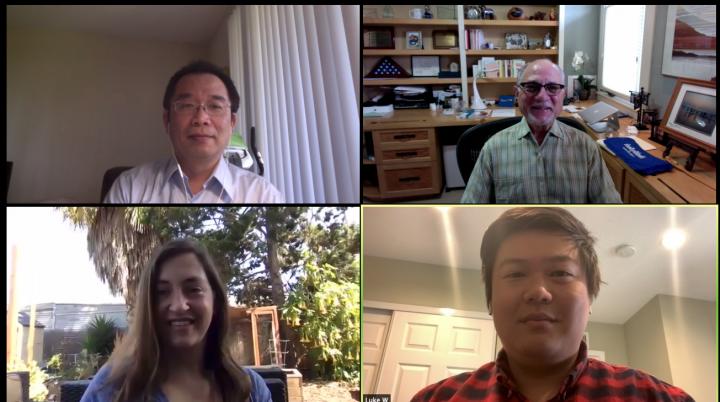Salk scientists uncover how RAS proteins bind and get destroyed, which may improve cancer therapeutics

Credit: Salk Institute
LA JOLLA–(May 18, 2020) Many cancer medications fail to effectively target the most commonly mutated cancer genes in humans, called RAS. Now, Salk Professor Geoffrey Wahl and a team of scientists have uncovered details into how normal RAS interacts with mutated RAS and other proteins in living cells for the first time. The findings, published in The Proceedings of the National Academy of Sciences on May 18, 2020, could aid in the development of better RAS-targeted cancer therapeutics.
“RAS proteins have been studied for decades because the RAS gene is changed (mutated) in so many cancers, yet there are still new things to be learned as we develop more sophisticated tools to study the problem,” says Wahl, co-corresponding author, professor in Salk’s Gene Expression Laboratory and holder of the Daniel and Martina Lewis Chair. “We have identified a new mechanism for regulating RAS enzyme activity that will help inform therapeutic strategies for inhibiting the mutated RAS proteins involved in cancer.”
The family of RAS genes helps to regulate cell communication (“signaling”) and growth. However, prior research suggests mutated RAS deviates from normal RAS in its ability to regulate processes that drive tumor growth across multiple types of cancer, including the majority of pancreatic cancers. Scientists have long attempted to target cancer-related RAS activity but this has proved very difficult. Efforts to understand which proteins normal and mutated RAS interact with in the cell have also given contradictory answers due to the difficulty of replicating the cellular environment in a test tube. And while previous studies have suggested that normal RAS proteins can bind to mutated RAS proteins to suppress tumor growth, exactly how these interactions happened was unknown.
“We improved upon an existing genetic technology developed by our lab, which allows us to study RAS protein interactions instantaneously in living cells,” says Yao-Cheng (Leo) Li, Salk project scientist who led this study. “The key to understanding the function of RAS is being able to accurately analyze protein interactions on the cell membrane. This new technology allows us to do that.”
Similar to watching a soccer team effortlessly execute a complicated play, the team used their high-powered genetic tool (which enables interacting proteins to light up, like fireflies) to examine how RAS interacted with other proteins, as well as with its mutated form, within living cells. They found that close proximity on the cell membrane was required for one RAS protein to interact with other RAS proteins, behavior the team coined “membrane association facilitated interactions” (MAFI). The cell membrane is required for RAS interactions with itself and some other proteins that localize to the same place on the cell membrane, which is why such interactions were not previously found in test tube studies.
The team also unexpectedly discovered a new mechanism for regulating the quantity of RAS proteins in the cell. They found that if they positioned a small fragment of a protein that interacts strongly with RAS on the membrane, MAFI would enable this protein to bind RAS very tightly, and this could inhibit RAS function better, creating an inactive RAS complex. The cell has a mechanism for detecting and eliminating inactive RAS complexes using small structures called lysosomes to perform this “housecleaning.” Because the cell died as a result of eliminating the RAS proteins, this new and unexpected finding may aid in the development of new cancer therapeutics.
“These findings define new mechanisms of RAS signaling regulation” says Nikki Lytle, an author of the paper and Salk postdoctoral fellow. “This provides an unexpected model for RAS suppression, which could lead to new strategies for targeting mutated RAS in the future.”
In the future, the researchers hope their discovery can be utilized to develop a new class of RAS-targeted therapeutics, which may require drug delivery through cutting-edge approaches involving nanoparticles or viruses that can target malignant cells.
###
Other authors included Luke Wang of Salk; Seth T. Gammon, Margie N. Sutton, Robert C. Bast, Jr., and David Piwnica-Worms of The University of Texas MD Anderson Cancer Center; Tikvah K. Hayes and Channing J. Der of the University of North Carolina at Chapel Hill; and Frank McCormick of the University of California, San Francisco.
The work was funded by a Salk Cancer Center Core Grant (CA014195), the Susan G. Komen Foundation (SAC110036), an NIH/National Cancer Institute (R35 CA197687), the Leona M. and Harry B. Helmsley Charitable Trust (2012-PG-MED002), the Freeberg Foundation, the Greenfields, Sorrento Biosciences and Genentech.
About the Salk Institute for Biological Studies:
Every cure has a starting point. The Salk Institute embodies Jonas Salk’s mission to dare to make dreams into reality. Its internationally renowned and award-winning scientists explore the very foundations of life, seeking new understandings in neuroscience, genetics, immunology, plant biology and more. The Institute is an independent nonprofit organization and architectural landmark: small by choice, intimate by nature and fearless in the face of any challenge. Be it cancer or Alzheimer’s, aging or diabetes, Salk is where cures begin. Learn more at: salk.edu.
Media Contact
Salk Communications
[email protected]
Original Source
https:/
Related Journal Article
http://dx.




